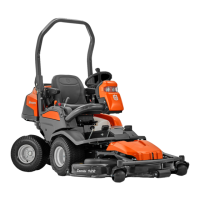English – 35
WARNING!
Risk of spray and burn injuries. The
engine’s oil lter may be very hot
immediately after stopping. Allow the
engine to cool down rst.
NB!
Replaced lters must be deposited is assigned
places for correct disposal.
Avoid skin contact, wash with soap and water
in case of spills. Avoid skin contact, wash with
soap and water in case of spills.
5.2.6 Replacing the engine oil lter
1. Follow “5.2.7 Changing engine oil” on page 35 to
- change oil lter if necessary.
2. Wipe clean the engine block around the oil
lter.
3. Remove the oil lter. If necessary, use a lter
remover.
4. Clean the oil lter’s mounting.
5. Wipe new, clean engine oil onto the seal for the
new lter.
6. Fit the lter by hand to contact + 3/4 turn.
7. Fill with new engine oil.
8. Run the engine warm, then check that there are
no leaks around the oil lter seal.
9. Check the oil level in the engine, top up if nec-
essary. The oil lter capacity is about 0.3 liters
of oil.
WARNING!
Engine oil can be very hot if it is
drained directly after stopping the
engine. Therefore allow the engine to
cool down rst.
NB!
Used engine oil is a health hazard and must
not be disposed of on the ground or into the
environment; it should always be disposed of
at an appropriate disposal site.
Avoid skin contact, wash with soap and water
in case of spills.
5.2.7 Changing engine oil
The engine oil should be changed the rst time
after 8 hours running time. Follow the intervals
specied in the Service Journal.
1. Run the machine warm.
2. Open the engine hood.
3. Place a container underneath the engine’s right
oil drain plug.
4. Remove the dipstick. Remove the drain plug on
the right of the engine.
Tools Dimension
Combination wrench
19 mm
5. Allow the oil to run into the vessel (1.9 l /
2.0 US qt).
6. Then screw in the drain plug and tighten it.
7. Change oil lter if necessary “5.2.6 Replacing
the engine oil lter” on page 35.
8. Fill with new engine oil.
9. Start the engine and run it for a few seconds.
Check the oil level and top up if necessary.
Refer to “2.4 Final inspection” on page 8.
Propulsion

